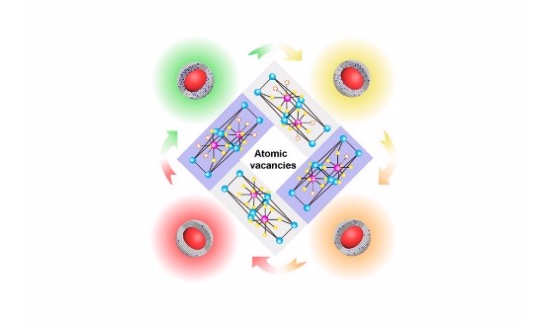(Correspondent: Mr. Jingzhao Huang) On June 5th, Prof. Xiangliang Yang and Assoc. Prof. Yan Zhang from National Research Centre for Nanomedicine, College of Life Science and Technology, jointly reported their original research work, entitled “Artificial Atomic Vacancies Tailor Near-Infrared II Excited Multiplexing Upconversion in Core−Shell Lanthanide Nanoparticles”, on Nano Letters, a journal from American Chemical Society (ACS) that aims to report original results on fundamental, applied, and emerging research in all areas of nanoscience and nanotechnology.

Lanthanide upconversion nanoparticles (UCNPs) emerge as promising optical reporters attractive in multiplexing security monitoring, biomolecules profiling, and clinical diagnosis. They produce spectrally distinctive upconversion emissions spanning from ultraviolet to near-infrared (NIR) range upon NIR irradiations with unique features including large anti-Stokes shift, narrow emission band width, excellent photostability as well as high signal-to-noise ratio. Epitaxial growth of inert shell around the optical active lanthanide UCNPs is a general strategy to enhance their brightness. Yet, its potential as a tool in multiplexing emission tailoring has rarely been reported. Here, by developing the atomic vacancies into color selectivity actuators, we present an efficient strategy to achieve inert shell-modulated multiplexing upconversion in 1540 nm-activated UCNPs. Artificially generated fluoride atomic vacancies, owing to the decreased NaOH/NH4F dosage during shell growth, reduce the coordination number of Y-F and lattice densities in the inert shell, leading to the core/engineered shell nanoparticles with distinctive emission profiles. The multicolor tailoring is independent of shell-thickness and can be readily applicable to Lu3+-/Gd3+-based shells. The upconversion emission can be exploited to visualize in security decoding and in vivo multiplexing bioimaging. This method of regulating atomic vacancies based on the inert shell engineering opens new insights of upconversion modulation in core/shell lanthanide nanostructures.
This work was funded by National Natural Science Foundation of China (81703031, 81773653 and 81672937), National Basic Research Program of China (2015CB931802), and Huazhong University of Science and Technology (2017KFYXJJ162).
Article Link:Huang J.*, Li J.*, Zhang X., Zhang W., Yu Z.#, Ling B., Yang X.#, Zhang Y.#, Artificial Atomic Vacancies Tailor Near-Infrared II Excited Multiplexing Upconversion in Core-Shell Lanthanide Nanoparticles, Nano Letters, 2020,DOI: acs.nanolett.0c01539